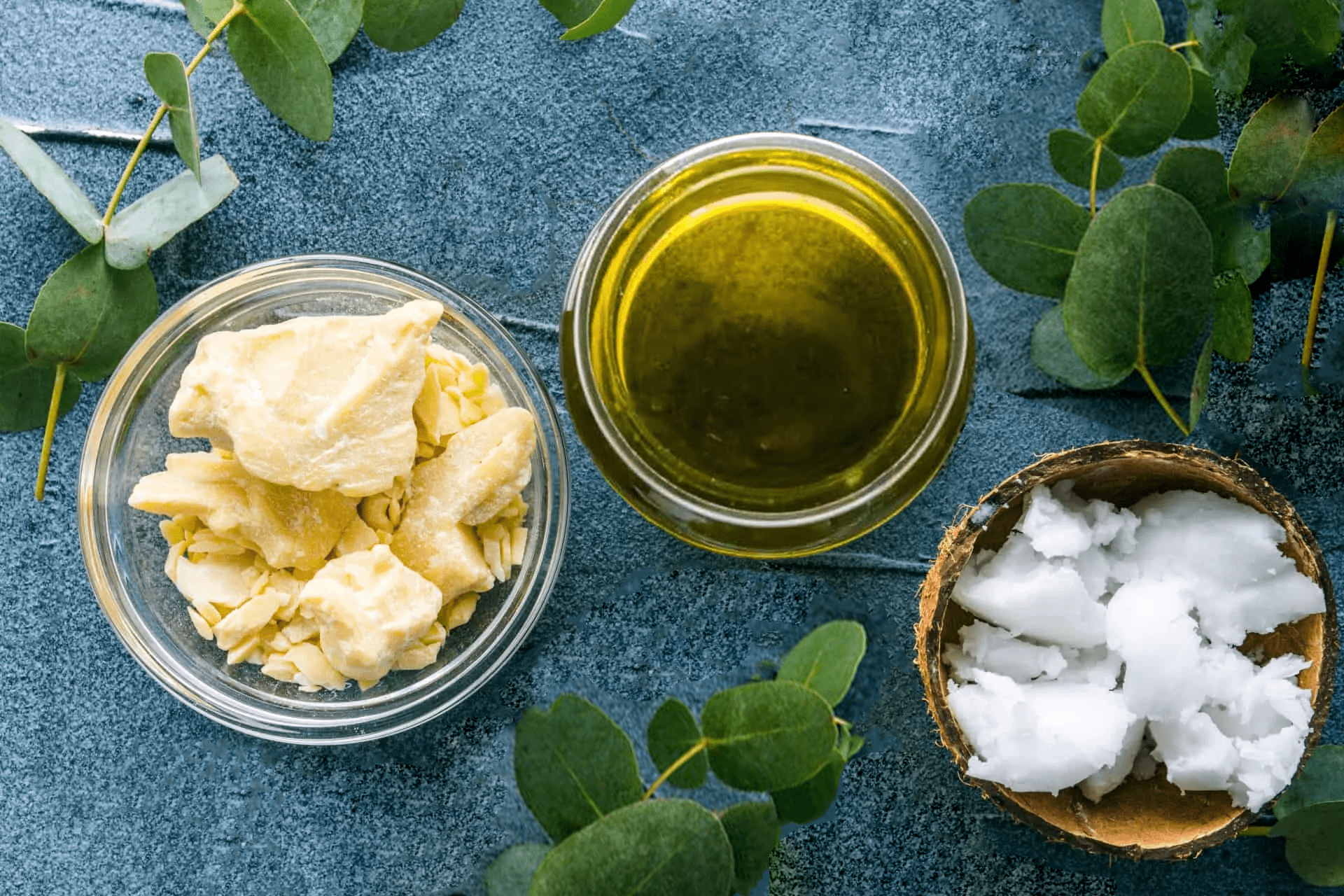
One of the easiest ways to get glowing, healthy-looking skin is to make sure your skin is effectively moisturized. Throughout the day, skin loses moisture, and as we age, our oil-producing glands lose productivity. This leads to drier skin that’s more prone to damage. These effects can easily be counterbalanced through the use of moisturizers, which help treat the skin when it’s dry and prevent it from drying out again. Knowing and understanding what key moisturizing agents are in products can help you reverse dry, patchy skin. Shea butter, coconut oil, and sustainable palm oil, for example, are excellent moisturizing ingredients that can leave skin feeling refreshed and soft all day long.
Shea butter has been used as a cosmetic ingredient for centuries. Its high concentration of vitamins and fatty acids — combined with its easy-to-spread consistency — make it a great agent for smoothing, soothing, and conditioning your skin.
Shea trees are native to West Africa with most shea butter still coming from that region. Shea butter is fat that’s extracted from the nuts of the shea tree. It comes from two oily kernels within the shea tree seed. After the kernel is removed from the seed, it’s ground into a powder and boiled in water. The butter then rises to the top of the water and becomes solid. Shea butter is solid at room temperature, and it has an off-white or ivory color.
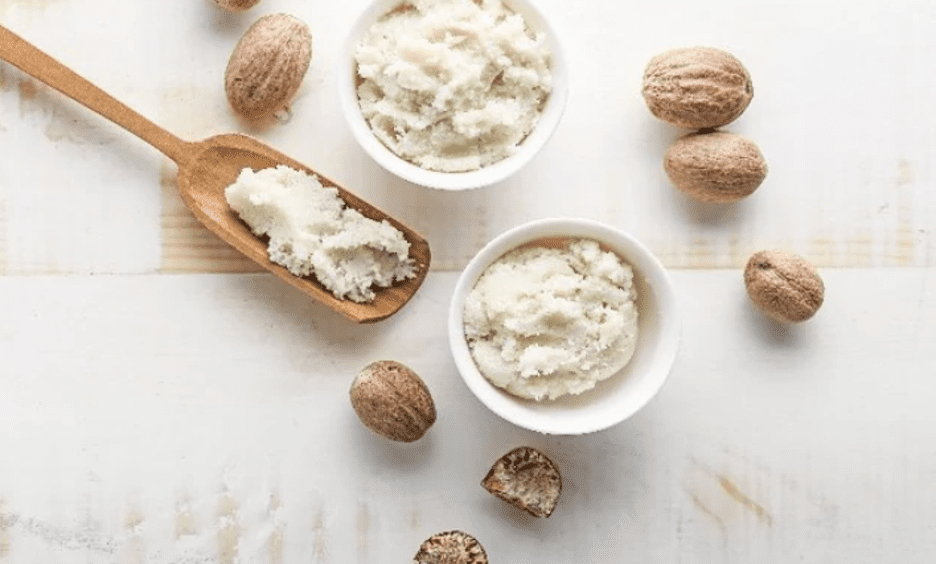
Source: SkinKraft
Shea butter has made its way into the formulas of the most tried-and-true skincare products due to its moisturizing and anti-inflammatory properties. Here’s a more in-depth look at the benefits of shea butter:
Shea butter works as an emollient to soften and condition the skin. Because it contains several types of fatty acids — including linoleic, oleic, palmitic, and stearic acids — shea butter improves the skin’s natural barrier and also protects skin from transepidermal water loss (TEWL).
Research from the Journal of Oleo Science notes shea butter’s anti-inflammatory compounds, which make it beneficial for soothing and nourishing upset skin. According to the Hong Kong Medical Journal, it’s often included in products that help heal inflammatory skin conditions like eczema and psoriasis, as well as sunburn-soothing products.
Shea butter is thought to have mild sun protection benefits — though it’s not strong enough to replace your sunscreen. Still, you might notice shea butter sneakily adding moisture to your suncare products. Shea butter alone has an estimated SPF of 3 to 4, so you can always layer it over your favorite sunscreen for added protection.
Dry, acne-prone skin tends to overproduce sebum, which can clog pores; however, shea butter stops this cycle in its tracks by helping to prevent your skin from drying out in the first place. Shea butter is rich in different kinds of fatty acids, making up a unique composition that helps clear your skin of excess sebum.
At the same time, shea butter restores moisture to your skin and locks it into your epidermis, so your skin doesn’t dry out or feel “stripped” of oil. The result is a restoration of the natural balance of oils in your skin — which may help stop acne before it starts.
According to the Journal of Agricultural and Food Chemistry, shea butter also contains quite a few antioxidants, including vitamins A and E, along with many of the same ones found in green tea, which is a known antioxidant powerhouse. While more research is needed to prove shea butter is an anti-aging ingredient, antioxidants (especially vitamin A) have been shown to prevent free radical damage when applied to the skin.
Additionally, shea butter contains triterpenes, which are naturally occurring compounds that are thought to deactivate collagen fiber destruction. By boosting collagen production and promoting new cell generation, shea butter may help reduce photoaging — the wrinkles and fine lines that the sun and environmental stress can create on skin.
Coconut oil comes from the nut (fruit) of the coconut palm. It contains medium-chain fatty acids, including capric acid, caprylic acid, myristic acid, palmitic acid, and lauric acid. These acids make up between 52% to 85% of coconut oil and provide a moisturizing effect when applied to your skin.
Coconut oil can be produced through dry or wet processing. Dry processing involves drying coconut meat to create kernels, pressing them to extract the oil, then bleaching and deodorizing them. This process forms refined coconut oil, which has a more neutral scent and higher smoke point. In wet processing, coconut oil is obtained from raw coconut meat — instead of dried — to create virgin coconut oil. This helps retain the coconut scent and results in a lower smoke point.
While refined coconut oil may be better suited for cooking at high temperatures, virgin coconut oil is a better choice for skin health. Not only does most of the existing research focus specifically on the effects of virgin coconut oil, but there’s also evidence that it may have added health benefits.
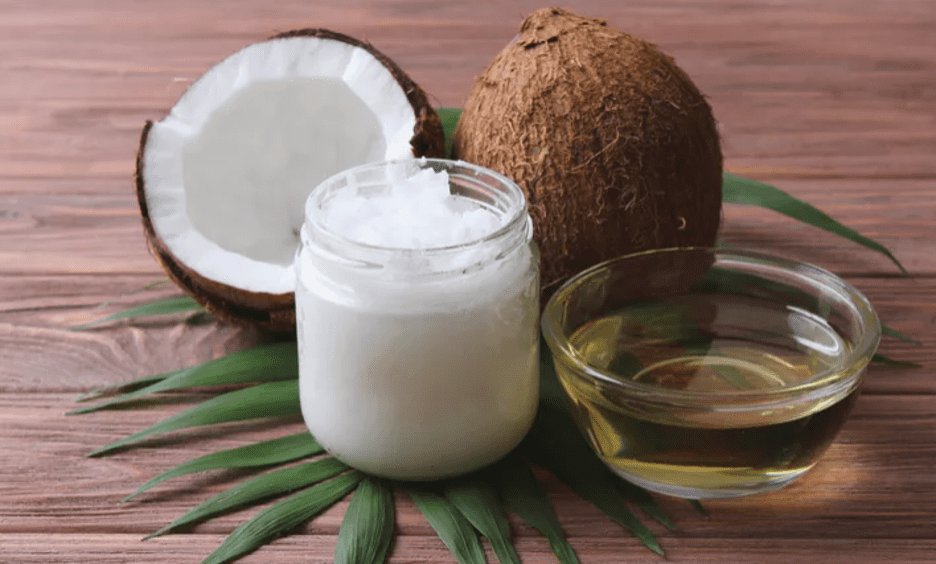
Source: Treehugger
By reputation, coconut oil is a magical elixir, used in both the kitchen and the bathroom for a multitude of different applications. From natural hair and skincare products to culinary recipes, coconut oil can be used almost anywhere for an array of benefits:
Applying coconut oil to your skin can help keep it hydrated. One study in patients with mild to moderately dry skin compared the effects of coconut oil to mineral oil, a type of oil made from petroleum that’s often used to treat dry skin. The two-week study found that coconut oil significantly improved skin hydration and was just as effective as mineral oil.1
Coconut oil has also been shown to help treat eczema, a skin condition characterized by scaly, itchy rashes. A study comparing the effects of olive oil and coconut oil in 52 adults with eczema found that applying coconut oil helped reduce dryness, in addition to helping treat the ailment.2
Another study found similar results, showing that coconut oil led to a 68% decrease in eczema severity, making it significantly more effective than mineral oil in the treatment process.3
While some think coconut oil clogs pores, considerable research shows it might help treat acne due to many of its components reducing inflammation in the body. Furthermore, the antibacterial properties of the medium-chain fatty acids in coconut oil could also help reduce acne.
Numerous studies have shown that lauric acid, which accounts for nearly half of the fatty acids in coconut oil, has been shown to kill off the strain of bacteria linked to acne. Studies have shown that lauric acid is more effective than benzoyl peroxide at preventing the growth of acne-causing bacteria.4
Along with lauric acid, capric acid has been shown to have anti-inflammatory and antibacterial properties. A 2014 study showed that both lauric and capric acid were successful in reducing inflammation and preventing acne by killing off bacteria.5
Chronic inflammation is a major component of many different types of skin disorders, including psoriasis, contact dermatitis, and eczema. In one study, researchers applied virgin coconut oil to the inflamed ears of subjects. Not only was coconut oil found to have an anti-inflammatory effect, but it relieved pain as well.6
What’s more, coconut oil may ease inflammation by improving its antioxidant status. Antioxidants work by stabilizing free radicals in the body, neutralizing the reactive atoms that can contribute to inflammation. A 2013 study found that in 45 days, virgin coconut oil had improved antioxidant status and prevented oxidative stress to the greatest extent.7
Several studies have demonstrated that coconut oil may also aid in wound healing. One study looked at how coconut oil applied to the skin affected wound healing. It found that treating wounds with virgin coconut oil sped up healing, improved antioxidant status, and increased levels of collagen, which is an important protein that aids in wound healing.8
Another study showed that coconut oil, combined with an antibiotic, applied to the skin was effective at healing burn wounds.9 In addition to improving wound healing, coconut oil’s antimicrobial properties may also prevent infection, one of the major risk factors that can complicate the healing process.
Palm oil can be found in everything from snacks and household cleaners to cosmetics. Versatile, affordable, and useful, palm oil is the most widely used vegetable oil in the world. But it has also caused deforestation and community conflict in the tropical countries where it’s cultivated. About 58.84 million tons of palm oil are produced every year, with Indonesia and Malaysia accounting for 85% of total output.
Palm oil is an edible vegetable oil that comes from the fruit of oil palm trees. Two types of oil can be produced; crude palm oil comes from squeezing the fleshy fruit, and palm kernel oil which comes from crushing the kernel, or the stone in the middle of the fruit. Oil palm trees are native to Africa but were brought to South-East Asia just over 100 years ago as an ornamental tree crop.
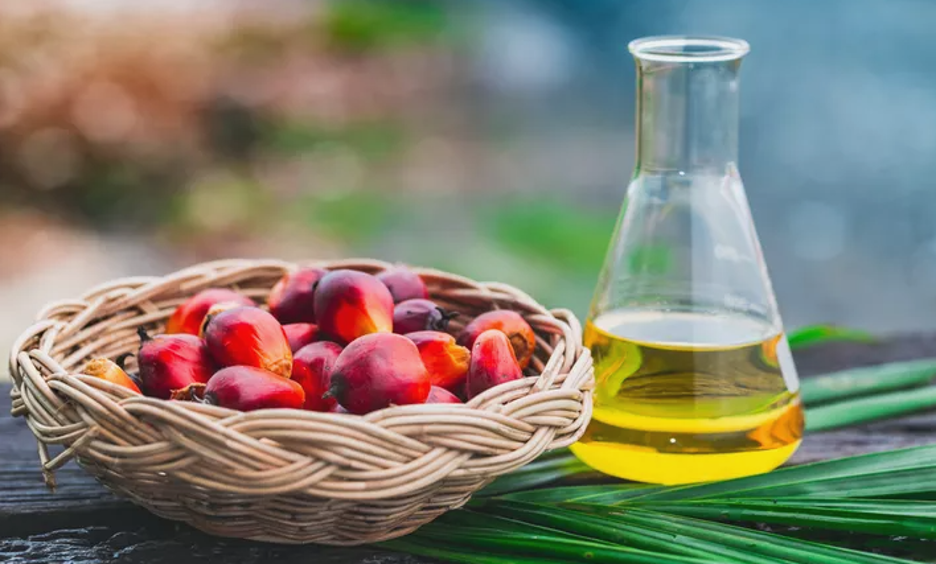
Source: Treehugger
It’s vital to ensure that the palm oil in the products you buy is sustainable. The World Wide Fund for Nature (WWF) indicates that about 300 football fields of forest are cleared every hour to make way for palm oil plantations.10
The problem is especially acute in Indonesia, the world’s biggest producer of palm oil, where a large proportion of palm oil plantations are situated on peat; a swampy, waterlogged soil that must be drained before companies can plant crops on it. Dry peat is extremely flammable. Given that many smallholder oil palm farmers can only afford to clear land by burning it, massive and uncontrollable peat fires engulf Southeast Asia in a choking haze every year.11
Boycotting palm oil is not the answer, considering that globally, palm oil supplies 40% of the world’s vegetable oil demand on just under 6% of the land used to produce all vegetable oils. To get the same amount of alternative oils like soybean, coconut, or sunflower oil you would need anywhere between 4 and 10 times more land, which would just shift the problem to other parts of the world and threaten other habitats, species, and communities.
Future demand for palm oil can be met without further forest and ecosystem conversion, notably by sustainably increasing productivity on existing plantations and expanding plantations to degraded land. To achieve this, palm oil majors have adopted policies that promise no deforestation, no peat development, and no exploitation (NDPE).
These policies are usually applicable across the company’s supply chains, including third-party suppliers and smallholders. They require farmers to stop burning land to clear it, assess land for high carbon stock and high conservation value before developing new plantations, and obtain land use permission from communities using a process known as “Free, Prior and Informed Consent.”
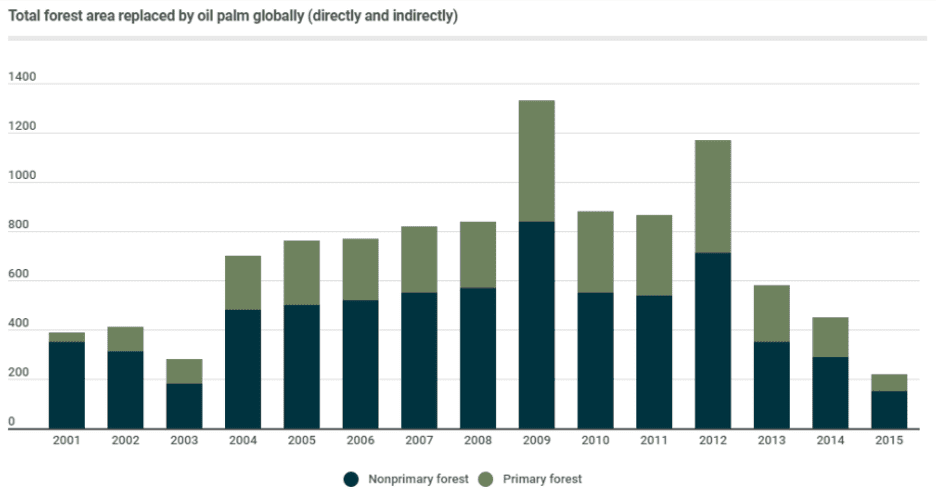
Pictured: Deforestation from the production of palm oil is decreasing due to sustainable palm oil efforts. Source: European Palm Oil Alliance
Palm oil is an extremely versatile oil that has many different properties, functions, and benefits that make it incredibly useful. A few of the most common benefits of palm oil for your skin include:
Palm oil contains tocotrienols, which are members of the vitamin E family. The common form of vitamin E, tocopherol, has long been used to treat many skin ailments and is found in many anti-aging products. Vitamin E is a strong antioxidant that helps your skin fight free radicals that damage the skin and cause fine lines and wrinkles.
As a stronger antioxidant than tocopherols, tocotrienols have been proven to be more effective in preventing aging and damage from free radicals. Used topically, as with tocopherol, tocotrienols can penetrate deep into the skin’s layers to enable healing and protection from the base up.
Palm oil is found in many shampoos, conditioners, soaps, lotions, creams, and foundations. In shampoos and soaps, it’s used for its ability to remove oil and dirt from your hair and skin. It also contains a refatting agent that helps restore your hair and skin’s natural oils that most soaps and shampoos strip away. It’s also a conditioning agent and is added to skincare products not only for its anti-aging properties but also because it deeply moisturizes to help make skin softer and more supple.
Tocotrienols may also support brain health. Animal and human studies suggest that the tocotrienols in palm oil may help protect the delicate polyunsaturated fats in the brain, slow dementia progression, reduce the risk of stroke and prevent the growth of brain lesions.12
Palm oil has been credited with protecting against heart disease. Although some study results have been mixed, palm oil generally appears to have beneficial effects on heart disease risk factors, including lowering “bad” LDL cholesterol and increasing “good” HDL cholesterol.13
Humanist Beauty has recently introduced 100% vegan botanical bar soaps that contain all of the above-mentioned moisturizers: shea butter, coconut oil, and sustainable palm oil. The Hand-Crafted Bar Soaps are aromatherapeutic as well as moisturizing, so they help to elevate your mood as you cleanse and condition your skin. The bars are small-batch made with essential oils, artisan-crafted in the US, and eco-conscious with no plastic wrapping or labels.
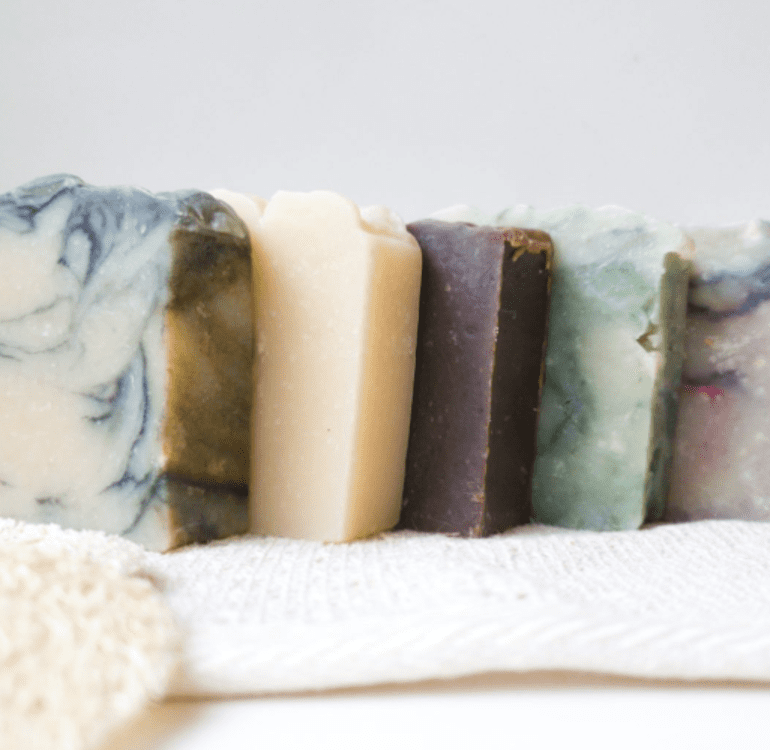
The 5 different aromatherapeutic Hand-Crafted Bar Soap recipes are:
You can shop the new Humanist Beauty Handcrafted Bar Soaps here.
—
References:
https://pubmed.ncbi.nlm.nih.gov/15724344/ [1]
https://pubmed.ncbi.nlm.nih.gov/19134433/ [2]
https://pubmed.ncbi.nlm.nih.gov/24320105/ [3]
https://pubmed.ncbi.nlm.nih.gov/19387482/ [4]
https://pubmed.ncbi.nlm.nih.gov/24284257/ [5]
https://pubmed.ncbi.nlm.nih.gov/20645831/ [6]
https://pubmed.ncbi.nlm.nih.gov/23892389/ [7]
https://pubmed.ncbi.nlm.nih.gov/20523108/ [8]
https://www.ncbi.nlm.nih.gov/pmc/articles/PMC2792613/ [9]

Disclaimer: Statements on this website have not been evaluated by the FDA. These products are not intended to diagnose, mitigate, treat, cure, or prevent any disease, nor are the products intended to affect the structure or any function of the body of man/woman or other animals. CANNABIDIOL USE WHILE PREGNANT OR BREASTFEEDING MAY BE HARMFUL. KEEP OUT OF REACH OF CHILDREN. Humanist Beauty Herban Wisdom products include hemp extract that contain less than 0.3% THC. Products containing CBD or THC are not to be used by or sold to persons under the age of 21.
We don’t retouch the skin of the model humans shown on this website. Keepin’ it real.